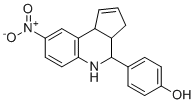| Description |
iBAP-II (BAP1 inhibitor II) is a next-generation, specific small molecule inhibitor of BAP1 histone H2A deubiquitinase activity with IC50 of <0.1 ug/mL.iBAP-II displays higher affinity for BAP1 than the closest UCH family member, UCHL5, and other deubiquitinases, such as USP5, USP7, USP8, TNFAIP3-catalytic domain, USP2-catalytic domain, Otubain-1, and Ataxin3.Inhibition of BAP1 via iBAP-II reduces ASXL3 protein stability in small cell lung cancer cells, without significant changes to ASXL1 and ASXL2 protein levels.iBAP-II suppresses ASCL1 expression in NCI-H1963 cells, along with the mRNA levels involving a handful of known ASCL1 transcriptional targeted genes, such as GRP, DMPK, RNF183, SCN3A, MYCL, and CACNA1A.iBAP-II exhibited more potent cell viability inhibition activity on four different BAP1-WT SCLC cell lines than iBAP.iBAP-II (50 mg/kg/d) significantly delayed the disease progression in SCLC xenograft model.
|
